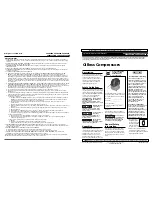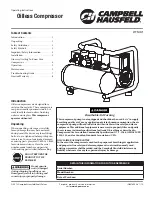
8
9
ASSEMBLY & SET UP
The air compressor is fitted with a standard 1/4" threaded air outlet which
is common for airbrush applications. If you need a different fitting, consult
your local hardware supplier for appropriate adapters as necessary for
your application.
1. Connect one end of air hose to compressor air outlet. Do not overtighten - "finger tight" should be
sufficient for most airbrush applications.
2. Connect the other end of air hose to airbrush.
3. Connect power cord to electrical outlet.
4. Turn on power switch. The compressor motor will run until maximum pressure is reached and then
shut off automatically. Check for air leaks. If air leakage occurs, teflon pipe thread tape can be
used to seal any leaks at air fittings.
5. To adjust the working pressure, pull the Pressure Regulator Knob up to unlock, then depress the
trigger on the airbrush to start the air flow. While the compressor is running and air is flowing
through the airbrush, turn the Pressure Regulator Knob clockwise to increase pressure, or
counter-clockwise to decrease pressure.
6. Once desired pressure is set, push the knob down to lock.
7. Once the setup is complete, the compressor should not operate unless the airbrush trigger is
depressed. Depressing the trigger will cause the Auto Start feature on the compressor to start the
motor. When the trigger is released, the Auto Stop feature will turn the compressor motor off.
If the compressor Auto Starts frequently when not in use or if pressure
decreases noticeably on the pressure gauge without the airbrush trigger
being depressed, there is an air leak somewhere in the system. Seal any
such leaks with pipe thread tape.
8. During normal operation, moisture will tend to accumulate in compressed air systems. The air
filter (below the air regulator) is equipped with a moisture trap which incorporates a clear housing
allowing any trapped moisture to be visible. Moisture must be purged periodically while working to
prevent it from contaminating the air hose, possibly mixing with the paint and ruining the paint job.
When moisture is visible in the clear housing, press the Moisture Release Needle upward while
the compressor is running to blow it out of the trap.
CARE AND MAINTENANCE
Always switch compressor to "OFF" and relieve any residual moisture and
pressure in the system before disconnecting airbrush and air hose.
Unplug compressor from power supply when not in use.
Frequently wipe compressor clean with a damp cloth and store in a dry environment free from dust or
other contaminants.
With proper care and maintenance, your compressor will give you years of satisfactory performance,
however, as with any mechanical device, occasional adjustments may become necessary.
If any
performance issues are encountered, consult the troubleshooting chart on the facing page.
TROUBLESHOOTING
Problem Encountered
Possible Cause
Corrective Action
Compressor motor does
not run
No power at outlet due to tripped circuit
breaker
Reset circuit breaker at panel
Power cord damaged
Replace power cord*
Loose electrical connections inside unit
Open rear plate and check electrical
connections - Repair as necessary*
Defective On/Off switch
Check switch and repair or replace*
Motor makes noise but does
not operate correctly
Exhaust outlet clogged
Open outlet cap and clean outlet
Cylinder valve incorrectly fitted
Reassemble cylinder valve making sure
direction or rotation is correct
Motor runs but makes
excessive or knocking noise
Bearing is loose or damaged
Check and replace bearing if necessary
Loose connecting rods
Tighten screws or replace connecting
rods
Insufficient paint spray or
poor paint atomization
Air pressure too low
Adjust air pressure at regulator
Seal air fittings with teflon tape
Replace hoses or fittings as necessary
Screws on cylinder cover are loose
Tighten screws
Paint too thick
Dilute with thinner per manufacturer's
instructions
Dirty or damaged airbrush needle/nozzle
Clean, repair or replace as necessary
Compressor motor runs,
but produces insufficient air
pressure
Valve plate is unscrewed or out of place
Open front cover and ensure correct
position - Tighten screws
Retainer ring worn from excessive use
Replace retainer ring
*WARNING: Electrical service should only be carried out by qualified electrical service personnel

























